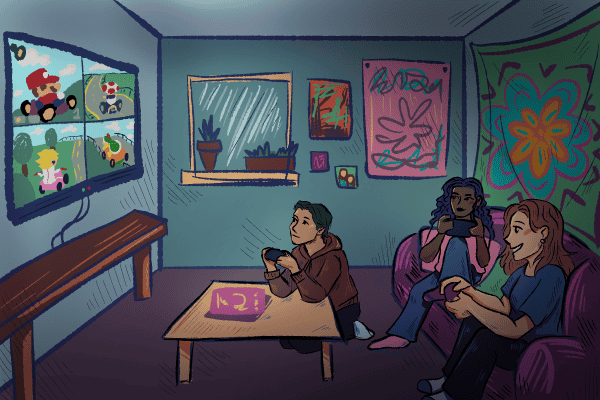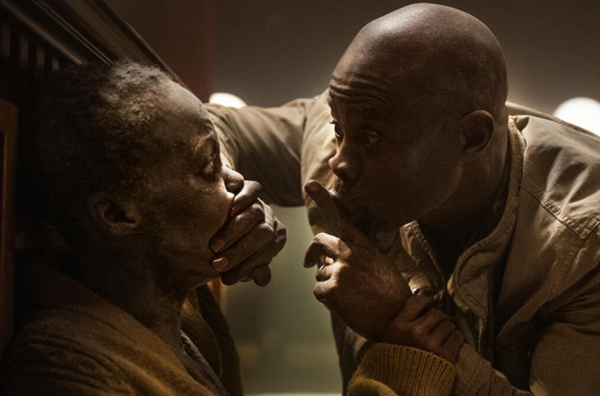The true origins of rock ’n’ roll
October 21, 2021
When most people hear rock ’n’ roll, they think of Elvis Presley, clad in his star-spangled jumpsuit, but they typically don’t think of the generations of Black musicians, like Little Richard or Fats Domino, who laid the foundations of rock music.
Alexis Davis-Hazell, an assistant professor of voice and lyric diction, who is Black, said it is impossible to talk about American music without talking about the African American tradition that goes into it.
“They are woven. You cannot talk about one without the other. It is a foundational element and it is part of what makes American music unique from other national music,” Davis-Hazell said.
Rock ’n’ roll is a genre spawned almost entirely from Black genres of music likes bluegrass, R&B, gospel and jazz. Like many things, it has been whitewashed by the pages of history books, the radio and movies.
The culture of mainstream American music is closely intertwined with racism and segregation.
According to the Oakland Public Library, Black music genres can be traced back to the days of slavery, when enslaved people would sing to each other to pass along messages and share their life stories.
As Christianity gradually made its way into the culture of slaves in the United States, the hymns they sang would eventually be termed spirituals, which would later evolve into gospel music. This became the foundation of the blues, a genre of music that expressed the Black community’s disappointment in the lack of freedoms and rights that came in a post-slavery, Jim Crow society.
Eric Weisbard, a professor of American studies, said the international craze for American music — most notably, rock ’n’ roll — began with minstrel shows, the theatrical act of white actors performing in blackface.
“The phrase ‘Jim Crow’ came from the beginning of blackface minstrelsy in the 1830s. An artist named Thomas Rice, a white artist, put tar on his face, pretended to be a Black person, and gave a song-and-dance routine called Jim Crow,” Weisbard said.
Weisbard said minstrel shows proved to be so internationally popular that Rice was taken to England to perform for royalty.
“Every part of the United States had its own acts of people doing this kind of work. Jim Crow names segregation and names the beginning of commercial American music as this international craze,” Weisbard said. “So it’s there 200 years ago, it’s there practically from the beginning.”
Davis-Hazell said that the genesis of rock ’n’ roll is not the first time aspects of Black culture have been co-opted by dominant white culture.
“It is a pattern that goes all the way back to the very first popular music of America that was a truly American form, which was blackface minstrelsy,” Davis-Hazell said. “That lays the foundation for the comfort and the commoditization of Black culture, whether it’s authentic or not.”
The overwhelming commercial success, prestige and recognition white rock ’n’ roll singers received compared to Black pioneers of the same genre are staggering.
There are many examples of white artists re-recording Black-owned songs, such as The Beatles covering “Please Mister Postman” by the Marvelettes, or Elvis Presley covering “Hound Dog,” which was originally written for Big Mama Thornton. These songs were copied and rearranged to be more digestible for a white audience.
“They would have the original race record in the control room, and be trying to copy it in every way possible,” Davis-Hazell said. “In other cases, they purposely changed the way that it was articulated to be more palatable to a wider audience. So the text was enunciated differently, the recording quality was usually better because it was a business property.”
Davis-Hazell said early rock ’n’ roll’s popularity with white teenagers allowed the nomenclature to catch on, going beyond white artists doing covers and gradually turning into white artists actually attempting to emulate the style.
“It’s absolutely the case that the history of American popular music turns on racial appropriation,” Weisbard said. “The idea that the same process of white people often loving Black music seems to constantly involve taking it and profiting from it in ways that many Black performers are not able to profit from.”
Weisbard said that every aspect of American entertainment involves trying to satisfy an audience and make a profit.
“Sometimes that meant catering to racism. Sometimes that meant finding ways to target a Black audience with Black artistry,” Weisbard said. “More often than not, the result was that Black performers in a commercial music industry were subject to disqualifications that white performers never had to think about.”
As entertainment executives sought to make a profit, Black artists like Sister Rosetta Tharpe, commonly known as the “Godmother of Rock ’n’ Roll,” and their contributions to music were forgotten.
Tharpe started playing and singing in church as a child prodigy at four years old, touring the South along with her mother’s evangelistic choir to hone her music skills.
Tharpe skyrocketed during the 1930s and ’40s, attaining mass popularity with her gospel songs infused with electric guitar. These infusions laid the foundation for the sound of rock ’n’ roll today, as Tharpe is regarded to be one of the most dominant inspirations for artists like Little Richard, Johnny Cash, Carl Perkins, Chuck Berry, Elvis Presley and Jerry Lee Lewis.
Little Richard, a direct product of Tharpe’s musical inspiration, was one of the first Black rock ’n’ roll performers who catered to gay audiences through his screaming vocals and excessive flamboyance, both of which have become rock ’n’ roll staples.
According to Florida State University, “Little Richard began garnering fans from both sides of the civil rights divide” after the release of his hit track “Tutti Frutti,” bringing Black and white fans together and challenging the harsh lines of segregation.
Davis-Hazell said the record industry was terrible about awarding royalties to Black singers and songwriters, citing Little Richard as one of the first examples of Black artists having their work stolen by white artists and receiving little to no credit.
“He was so frustrated with the industry that he left,” Davis-Hazell said. “He went back to his church and went into ministry because he was so frustrated with Pat Boone.”
Davis-Hazell said Pat Boone was essentially taking every Little Richard track and re-recording them as covers or passing them off as his own, which generated success that Little Richard had never seen.
Fats Domino was another Black artist who helped open the floodgates of rock ’n’ roll through his vigorous piano playing, which quickly became as crucial to rock ’n’ roll as the guitar.
The original wave of Black rock artists would pave the way for more Black excellence in the industry, with ambidextrous guitar player Jimi Hendrix fusing electric guitar chords with distorted rhythmic tone effects, as well as Michael Jackson and Prince taking pop music by storm in the 1980s.
Despite its rich and profoundly Black history, rock ’n’ roll is another facet of Black culture lost to systemic racism and oppression.
“Because of segregation and going all the way back, we have legislated efforts to keep Black culture separate, but it’s not possible. You can’t keep it separate. Inevitably, people like it, people want to participate, people want to adopt it,” Davis-Hazell said. “So then what happens is because of the power differentials, the dominant culture can just take it.”
Davis-Hazell said because the nomenclature tends to go along with whatever has been adopted by the dominant culture, the ideal is no longer thought of as Black anymore, a cycle that continues to repeat itself.
Weisbard said the country finds itself at a moment where the status-quo structures once taken for granted are being called into question. While history is not being rewritten, the country is reaching a critical moment in time when the history is being told by people more central to the story.
“What contemporary Black performers can accomplish makes for a striking contrast with the limits faced 65 years ago,” Weisbard said. “I also think that on some fundamental level, there’s a sense of excitement about getting to tell the story of American popular music over again and put different figures at the front of the story.”
Now, with social media, the erasure of Black creatives has shifted.
“The virtue of social media, especially with so much being video and timestamp, it’s documentation, which is fantastic. You can trace things back to the source, you can look to see what time someone posts something on what day, and you can prove who did it first,” Davis-Hazell said. “But it also means that things spread faster and are absorbed by the larger culture faster.”
This has been exemplified on TikTok as many white TikTok creators have faced criticism after taking credit for dances originally performed and choreographed by Black creators with smaller followings.
As discussions of accurately crediting Black artists, past and present, occur, Davis-Hazell encourages people to dive deeper into these moments of history that are “painful and uncomfortable” because of their connection to the present.
This story was published in the Legacy Edition. View the complete issue here.
Questions? Email the Culture desk at [email protected].











